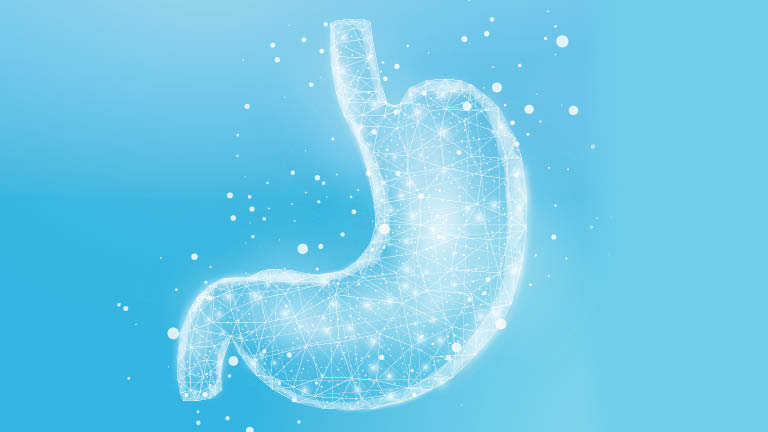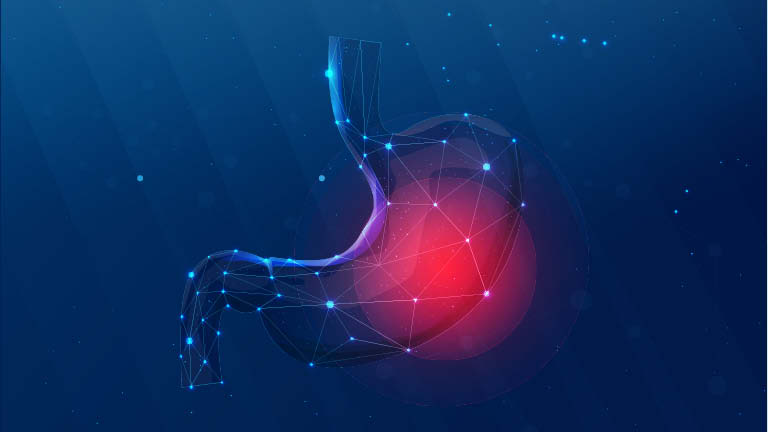Stomach
The foods we take orally (vitamins, minerals, carbohydrates, fats, proteins and liquids) reach the stomach after passing through the esophagus. The junction of the stomach and esophagus is called the gastroesophageal junction. The stomach is a J-shaped digestive organ located in the upper part of the abdomen. After the foods are processed with gastric juice and partially digested, they pass to the first part of the small intestine, the duodenum, the small intestines, and from there to the large intestines.

Stomach; It is adjacent to the large intestine, liver, spleen, small intestines and pancreas.
Parts of the stomach
- Cardia; the part closest to the esophagus, the first part of the stomach
- Fundus; upper part of stomach after cardia
- Corpus; the main part of the stomach, the part between the lower and upper part
- Antrum; lower part (near the intestines), where food mixes with gastric juice
- Pylorus; the last part of the stomach acts as a valve, controlling the passage of stomach contents into the small intestines
GASTRIC CANCER
Uncontrolled increase and spread of unhealthy cells originating from stomach tissue.
WHAT ARE THE RISK FACTORS FOR STOMACH CANCER?

- Some diseases;
- Helicobacter pylori (H. Pylori) infection of the stomach
- Chronic gastritis (inflammation of the stomach)
- Pernicious anemia (a type of anemia)
- Intestinal metaplasia (replacement of stomach cell structure with small intestine cell structure)
- Familial adenomatous polyposis or gastric polyp
- Consuming excessively salty, smoked and canned foods,
- Less consumption of vegetables and fruits.
- Eating foods that are not prepared and preserved under appropriate conditions.
- Advanced age and male gender. 95% of stomach cancers occur over the age of 55.
- Smoking
- Presence of stomach cancer in parents and siblings; It increases the risk of stomach cancer 2-3 times.
WHAT ARE THE SYMPTOMS SEEN IN GASTRIC CANCER?

- Indigestion
- Bloating and feeling of fullness after meals
- Mild nausea
- Anorexia
- Heartburn, burning
- Blood in stool
- Vomiting
- Unexpected weight loss
- Stomache ache
- jaundice
- Ascites (fluid collection in the abdomen)
- Difficulty in swallowing
In more advanced stages;
WHAT ARE THE TYPES OF GASTRIC CANCER?
- Adenocancer; It originates from the glandular cells that line the inside of the stomach. These cells secrete mucus that protects the stomach from acid and digestive enzymes. Adenocancers constitute 90-95% of stomach cancers.
- Lymphoma; Small amounts of immune system cells are also found in the stomach wall. Cancer arising from these is called lymphoma. They are seen in 4%.
- Carcinoid cancer; Although it is a rare cancer in the stomach, it originates from cells that secrete hormones.
- Gastrointestinal stromal tumor (GIST); It originates from certain specialized nerve cells (Cajal cells). It is rare in the stomach.
Since other types of stomach cancer are less common, adenocarcinomas usually come to mind when we talk about gastric cancer.
HOW IS THE DIAGNOSIS OF GASTRIC CANCER MADE?
- Physical examination and listening to the patient's story
- blood tests; Especially low blood count due to insidious or significant bleeding, carcino-embryonic antigen (CEA) is a tumor marker in the blood. It may also be elevated in stomach cancer or some other types of cancer.
- Endoscopy; Examination of the esophagus, stomach and duodenum by entering through the mouth with a thin finger-thick and bendable tube with a video camera system and a light at the end.
- Barium graphy; X-rays of the esophagus, stomach and duodenum after patients drink a contrast liquid containing barium by mouth
- Computed tomography
- Biopsy
What are the treatment options in gastric cancer and what are the factors that determine the prognosis of the disease?
- Stage of the cancer (is the cancer confined to the stomach only, has it spread to the lymph nodes or different parts of the body?)
- General health status of the patient
What are the methods used in gastric cancer staging?
- Endoscopic Ultrasonography (EUS)
- Computed tomography
- PET - CT (Positron emission tomography)
GASTRIC CANCER STAGING
Adenocancer stages
- Stage I; Cancer is limited to the tissues lining the inner surface of stomach. It may also show limited spread to surrounding lymph nodes.
- Stage II; There is involvement in the deeper layers of the stomach wall up to the muscle layer. It may also have spread to lymph nodes.
- Stage III; Cancer may involve all layers of the stomach wall and may be accompanied by widespread lymph node involvement.
- Stage IV; The cancer has also spread to distant parts of the body.
WHAT ARE THE TREATMENT OPTIONS IN GASTRIC CANCER?
- Endoscopic mucosal resection;
It is the removal of those tissues with the help of endoscopy in cancers that are very small and only involve the superficial layer that covers the inner surface of the stomach. - Surgery;
It is the removal of all cancerous stomach tissue together with a portion of healthy stomach in order to obtain a surgical margin without leaving a tumor behind. The stomach has a very rich lymphatic circulation, so it often spreads to lymphatic vessels and nodules. Therefore, it is important to remove the lymph nodes during gastric surgery. - Surgery to relieve symptoms In advanced gastric cancer, a part of the stomach is removed when the tumor causes a complete blockage that cannot be eaten, or life-threatening severe bleeding that cannot be controlled by other interventions. Surgery is aimed at increasing the patient's life comfort rather than treating cancer.
- If the cancer is blocking the stomach and cannot be removed with standard surgery;
- Endoluminal Stent (tube) placement; Placing a thin and expandable tube into the stomach to include the part occluded by the cancer so that the patient can be fed orally again
- Endoluminal Laser therapy; Damage to the cancer tissue that causes obstruction by entering the stomach with an endoscope in which the laser apparatus is placed
- Gastrojejunostomy; It is the process of joining (bypass) a stomach part before the obstruction in the stomach and a small intestine after the obstruction. In this surgery, the cancerous tissue remains in place, but the way for the patient to be fed orally and take his medications is opened.
- Chemotherapy
- Radiotherapy (Radiation therapy)
- Chemoradiotherapy
- Targeted therapies
Subtotal gastrectomy; It is the removal of the cancerous part of the stomach, regional lymph nodes, and, if necessary, neighboring organs (such as pancreas, large intestine) where it spreads. The entire stomach is not removed. Sometimes, the spleen may also have to be removed with this surgery.
Total gastrectomy; Removal of the entire stomach, part of the esophagus and small intestines and regional lymph nodes, and, if necessary, neighboring organs (such as pancreas, large intestine) to which it spreads. Sometimes, the spleen may also have to be removed with this surgery. Afterwards, a new pathway is created by combining the small intestines with the esophagus.
